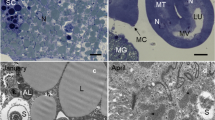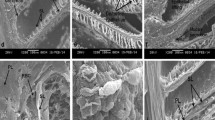Abstract
Using histological techniques together with transmission electron microscopy and X-ray microanalysis, copper-containing granules (which also contain significant amounts of sulphur) have been observed in the cells of the malpighian tubules and in the subcuticular region of larvae of Plectrocnemia conspersa. It is suggested that the granules in both these regions are primarily pigment granules, which provide a mechanism for taking potentially toxic concentrations of copper (and possibly other metals) out of circulation. This mechanism of metal tolerance may in part account for the reported occurrence of larvae of P. conspersa in waters with elevated concentrations of trace metals.
Similar content being viewed by others
References
Armitage, P. D., 1980. The effects of mine drainage and organic enrichment on benthos in the River Nent system, Northern Pennines. Hydrobiologia 74: 119–128.
Ballan-Dufrançais, C., A. Y. Jeantet & M. R. Martoja, 1971. Composition ionique et signification physiologique des accumulations minérales de l'intestin moyen des Insectes. C. r. Acad. Sci., Paris 273: 173–176.
Brown, B. E., 1977. Uptake of copper and lead by a metal-tolerant isopod Asellus meridianus Rac. Freshwat. Biol. 7: 235–244.
Brown, B. E., 1982. The form and function of metal-containing ‘granules’ in invertebrate tissues. Biol. Rev. 57: 621–667.
Bryan, G. W., 1974. Adaptation of an estuarine polychaete to sediments containing high concentrations of heavy metals. In F. J. Vernberg & W. B. Vernberg (eds), Pollution and physiology of marine organisms. Academic Press, New York: 123–135.
Burrows, I. G. & B. A. Whitton, 1983. Heavy metals in water, sediments and invertebrates from a metal-contaminated river free of organic pollution. Hydrobiologia 106: 263–273.
Darlington, S. T., A. M. Gower & L. Ebdon, 1986. The measurement of copper in individual aquatic insect larvae. Envir. Technol. Letters 7: 141–146.
Darlington, S. T., A. M. Gower & L. Ebdon, 1987. Studies on Plectrocnemia conspersa (Curtis) in copper contaminated streams in South West England. In M. Bournaud & H. Tachet (eds), Proc. of the 5th Int. Symp. on Trichoptera. Junk, Dordrecht, The Netherlands: 353–357.
George, S. G., B. J. S. Pirie, A. R. Cheyne, T. L. Coombs & P. T. Grant, 1978. Detoxification of metals by marine bivalves: An ultra-structural study of the compartmentation of copper and zinc in the oyster, Ostrea edulis. Mar. Biol. 45: 147–156.
Hildrew, A. G. & C. R. Townsend, 1976. The distribution of two predators and their prey in an iron rich stream. J. anim. Ecol. 45: 41–57.
Icely, J. D. & Nott, 1980. Accumulation of copper within the ‘hepatopancreatic’ caeca of Corophium volutator (Crustacea: Amphipoda). Mar. Biol. 57: 193–199.
Kikkawa, H., Z. Ogita & S. Fujito, 1955. Nature of pigments derived from tyrosine and tryptophan in animals. Science 121: 43–47.
Lachenmayer, E., P. Kunze & J. Holzinger, 1985. Schwermetalle in Nahrungstieen and Eiern der Wasseramsel (Cinclus cinclus) and Gebirgsstelze (Motacilla cinerea) im Kirchheimer Raum. Okol. Vogel 7: 327–351.
Lhonoré, D., 1973. Données histophysiologiques sur le développement post-embryonnaire d'un insecte Trichoptère. Ann. Limnol. 9: 157–176.
Namminga, H. & J. Wilhm, 1977. Heavy metals in water, sediments, and chironomids. J. Wat. Pollut. Cont. Fed. 49: 1725–1731.
Smock, L. A., 1983. Relationships between metal concentrations and organism size in aquatic insects. Freshwat. Biol. 13: 313–321.
Stoner, J. H., A. S. Gee & K. R. Wade, 1984. The effects of acidification on the ecology of streams in the Upper Tywi catchment in West Wales. Envir. Pollut. (A) 35: 125–157.
Tapp, R. L. & Hockaday, 1977. Combined histochemical and X-ray microanalytical studies on the copper-accumulating granules in the mid-gut of larval Drosophila. J. Cell Sci. 26: 201–215.
Walker, G., 1977. ‘Copper’ granules in the barnacle Balanus balanoides. Mar. Biol. 39: 343–349.
Author information
Authors and Affiliations
Rights and permissions
About this article
Cite this article
Darlington, S.T., Gower, A.M. Location of copper in larvae of Plectrocnemia conspersa (Curtis) (Trichoptera) exposed to elevated metal concentrations in a mine drainage stream. Hydrobiologia 196, 91–100 (1990). https://doi.org/10.1007/BF00008896
Received:
Accepted:
Issue Date:
DOI: https://doi.org/10.1007/BF00008896




